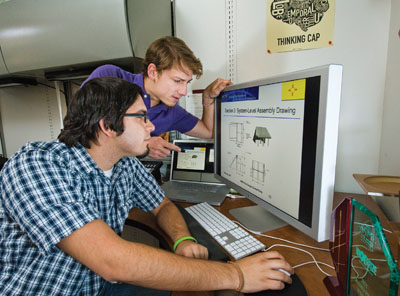Austin Silva (1462) and Tyler Bushnell (6121) were recently awarded the first place, $6,000 prize from the American Society of Mechanical Engineers of New Mexico for designing a life-saving device. The winners were announced at the Engineers Week luncheon by New Mexico Society of Professional Engineers on Friday, Feb. 25.
The four-week ASME competition’s requirement was to design a practical, self-contained, multienergy source that serves as a life-saving device in the event of a natural or manmade disaster in a coastal area.

Austin says it all started with a back-of-napkin basic concept. “From there we bounced ideas around, fed off each other’s energy, and the winning design was born.”
“I have discovered a new world through design and engineering,” Tyler says. “We’ve created a perfect shelter for use in a disaster. Working on the design ensured it was realistic and used a natural solution – solar energy.”
Their concept arrives in a box covered in a thick clear plastic, which is disassembled and reassembled in the form of a raised solar-still desalinator with a tent. The main idea is to use a shelter to conserve heat, and use cooking and heating energy to assist in the desalination process. The solar-still reservoirs are raised and made of steel so that heat, either from cooking or a built fire can be used to accelerate evaporation, and is not lost to the atmosphere.
“Our concept is ready for commercialization,” says Tyler.
Austin and Tyler met as freshmen at New Mexico Tech, and have been good friends ever since. Austin is now a Sandian who has recently been accepted into the Masters Fellowship program and Tyler is an intern who will receive his undergraduate degree in mechanical engineering in May.
Austin’s undergraduate degree was in electrical engineering but his interests changed. During his time at Sandia, he got involved with projects in cognitive science and how it relates to the human-computer interaction. “Cognitive science is a very important emerging field and the implications that it has on the world are very exciting to me,” he says.
Austin is currently working on a project at Sandia that uses electroencephalography (EEG) to study the effects of cognitive training on memory. Through his fellowship he is looking forward to receiving formal training in this field and bringing it back to support Sandia’s mission.
This project interested Austin because one of his passions is human-centered design. He would like to use science and engineering to improve the lives of people throughout the world. He was a co-founder of Engineers Without Borders student chapter at New Mexico Tech.
“This design competition was the perfect platform for Tyler and me to display our abilities as globally conscious engineers and designers,” Austin says. “We would like this design to become a manufactured reality. The world needs this right now.”
Tyler plans to one day pursue his doctorate in design optimization and methodologies. He is interested in exploring the connections between engineering design, psychology, and politics. “The principles of engineering are ultimately about problem solving,” he says.
Tyler has been working in wind power at Sandia since the summer of 2010. “It has given me an opportunity to develop my skills as an engineer and to apply my education to real-world problems,” he says. “I wanted to include a wind turbine in our concept’s design, but it wouldn’t fit.”
He draws much of his inspiration from travels around the country and abroad, as well as his time working at Walt Disney World. “It’s important to hold the details and the big picture in your head at the same time,” he mentions, “otherwise you can miss the obvious.”
Originally inspired by architecture, he has held graphic and web design jobs. Tyler admits to getting heavily involved in school design projects and seeks out competitions. “I can’t get enough of it,” he says. “It is the thrill of creation.”
Since winning the competition, Austin and Tyler have been invited to multiple presentations showcasing their design. They plan on turning this into New Mexican jobs and a product that the Red Cross or other philanthropic organizations can use to save lives.